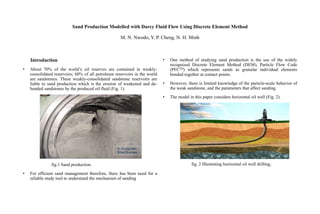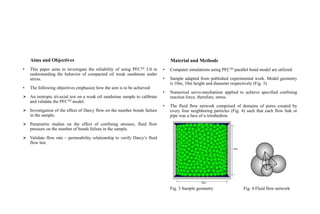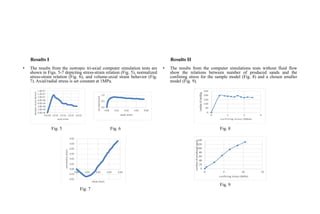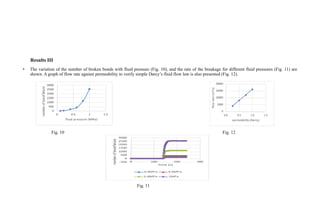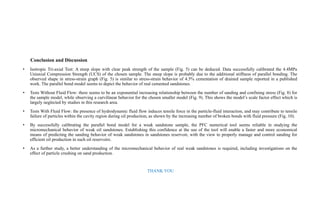Eposter_Presentation_Paris_2016
- 1. Sand Production Modelled with Darcy Fluid Flow Using Discrete Element Method M. N. Nwodo, Y. P. Cheng, N. H. Minh Introduction ÔÇó About 70% of the worldÔÇÖs oil reserves are contained in weakly- consolidated reservoirs; 60% of all petroleum reservoirs in the world are sandstones. These weakly-consolidated sandstone reservoirs are liable to sand production which is the erosion of weakened and de- bonded sandstones by the produced oil fluid (Fig. 1). fig.1 Sand production. ÔÇó For efficient sand management therefore, there has been need for a reliable study tool to understand the mechanism of sanding ÔÇó One method of studying sand production is the use of the widely recognized Discrete Element Method (DEM), Particle Flow Code (PFC3D) which represents sands as granular individual elements bonded together at contact points. ÔÇó However, there is limited knowledge of the particle-scale behavior of the weak sandstone, and the parameters that affect sanding. ÔÇó The model in this paper considers horizontal oil well (Fig. 2). fig. 2 Illustrating horizontal oil well drilling.
- 2. Aims and Objectives ÔÇó This paper aims to investigate the reliability of using PFC3D 3.0 in understanding the behavior of compacted oil weak sandstone under stress. ÔÇó The following objectives emphasize how the aim is to be achieved: ´âÿ An isotropic tri-axial test on a weak oil sandstone sample to calibrate and validate the PFC3D model. ´âÿ Investigation of the effect of Darcy flow on the number bonds failure in the sample. ´âÿ Parametric studies on the effect of confining stresses, fluid flow pressure on the number of bonds failure in the sample. ´âÿ Validate flow rate ÔÇô permeability relationship to verify DarcyÔÇÖs fluid flow law. Material and Methods ÔÇó Computer simulations using PFC3D parallel bond model are utilized. ÔÇó Sample adapted from published experimental work. Model geometry is 10m, 10m height and diameter respectively (Fig. 3). ÔÇó Numerical servo-mechanism applied to achieve specified confining reaction force, therefore, stress. ÔÇó The fluid flow network comprised of domains of pores created by every four neighboring particles (Fig. 4) such that each flow link or pipe was a face of a tetrahedron. Fig. 3 Sample geometry Fig. 4 Fluid flow network
- 3. Results I ÔÇó The results from the isotropic tri-axial computer simulation tests are shown in Figs. 5-7 depicting stress-strain relation (Fig. 5), normalized stress-strain relation (Fig. 6), and volume-axial strain behavior (Fig. 7). Axial/radial stress is set constant at 1MPa. Fig. 5 Fig. 6 Fig. 7 Results II ÔÇó The results from the computer simulations tests without fluid flow show the relations between number of produced sands and the confining stress for the sample model (Fig. 8) and a chosen smaller model (Fig. 9). Fig. 8 Fig. 9
- 4. Results III ÔÇó The variation of the number of broken bonds with fluid pressure (Fig. 10), and the rate of the breakage for different fluid pressures (Fig. 11) are shown. A graph of flow rate against permeability to verify simple DarcyÔÇÖs fluid flow law is also presented (Fig. 12). Fig. 10 Fig. 12 Fig. 11
- 5. Conclusion and Discussion ÔÇó Isotropic Tri-axial Test: A steep slope with clear peak strength of the sample (Fig. 5) can be deduced. Data successfully calibrated the 4.4MPa Uniaxial Compression Strength (UCS) of the chosen sample. The steep slope is probably due to the additional stiffness of parallel bonding. The observed shape in stress-strain graph (Fig. 5) is similar to stress-strain behavior of 4.5% cementation of drained sample reported in a published work. The parallel bond model seems to depict the behavior of real cemented sandstones. ÔÇó Tests Without Fluid Flow: there seems to be an exponential increasing relationship between the number of sanding and confining stress (Fig. 8) for the sample model, while observing a curvilinear behavior for the chosen smaller model (Fig. 9). This shows the modelÔÇÖs scale factor effect which is largely neglected by studies in this research area. ÔÇó Tests With Fluid Flow: the presence of hydrodynamic fluid flow induces tensile force in the particle-fluid interaction, and may contribute to tensile failure of particles within the cavity region during oil production, as shown by the increasing number of broken bonds with fluid pressure (Fig. 10). ÔÇó By successfully calibrating the parallel bond model for a weak sandstone sample, the PFC numerical tool seems reliable in studying the micromechanical behavior of weak oil sandstones. Establishing this confidence at the use of the tool will enable a faster and more economical means of predicting the sanding behavior of weak sandstones in sandstones reservoir, with the view to properly manage and control sanding for efficient oil production in such oil reservoirs. ÔÇó As a further study, a better understanding of the micromechanical behavior of real weak sandstones is required, including investigations on the effect of particle crushing on sand production. THANK YOU
